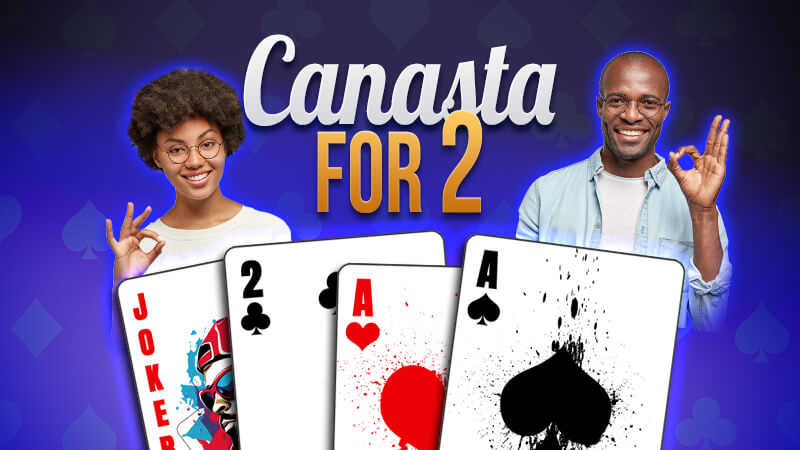Table of Contents
For more similar examples, check out our article on 2-player card games.
1. Overview of Canasta
Traditionally, Canasta is played by four players, divided into two partnerships. The game involves using two standard decks of playing cards, including Jokers, for a total of 108 cards. Each player is dealt a hand of 11 cards, and the remaining cards are placed in a draw-and-discard pile.
The standard rules of Canasta for 4 players require players to form melds of at least seven cards of the same rank. Points are scored for these melds, and special bonuses are awarded for Canastas, which are melds of seven or more cards of the same rank, including wild cards. Players aim to reach a target score or be the first to go out by playing all their cards, which ends the round.
2. How to Play Canasta with 2 Players
Two players can enjoy a modified version of Classic Canasta by making specific adjustments to the rules. Here’s a breakdown of these rule modifications:
Dealing. During the dealing phase, each player is distributed a sizable hand of 15 cards, deviating from the conventional 11-card distribution.
Drawing the stock. Usually players draw the top two cards during their turn. However, in a two-player Canasta, at the conclusion of a player’s turn, only one card is discarded, maintaining the customary practice of the game.
Going out. A pivotal alteration in the two-player version involves the criteria for “going out.” To achieve this, a player is required to construct two canastas, mirroring the standard four-player Classic Canasta rules. This modification intensifies the challenge and strategic depth, as players must adeptly navigate the game to form two canastas to secure victory.
Get 5000 points. Despite these adjustments, the majority of rules in the two-player Canasta variant align with those of the four-player version. The target score for triumph remains set at 5000 points, and the player boasting the higher score emerges victorious when either one or both players attain or surpass this predefined score.
When one card remains in the stock, the player drawing the last card undergoes a distinctive resolution. Considered to have completed a full draw, this player must navigate the conclusion of their turn as if two cards were drawn, adding an extra layer of strategic complexity to the game. This particular circumstance demands players to adapt swiftly to the reduced options available and make shrewd decisions to maximize their chances of success.
When drawing a red three. If a player happens to draw a red three as one of the last two cards from the stock, no replacement card can be drawn, and it’s treated as a one-card draw, following the previously mentioned one-card draw rules. Furthermore, if a player draws a red three alone as the last card from the stock, they may neither meld nor discard, and the hand ends immediately. The same applies when a player draws two red threes as the last two cards from the stock.
3. Scoring
For a successful going out, a player gets 100 points. For achieving a concealed “going out,” where the entire hand is melded in one turn, including at least one canasta, the player gets an additional 100 points, resulting in a total of 200 for going out.
- For each natural (red) canasta: 500 points.
- For each mixed (black) canasta: 300 points.
- For each red three laid out, provided the team has at least one meld: 100 points.
- For laying out all four red threes: an extra 400 points, amounting to 800 for red threes.
To score the bonus for going out concealed, the player must not have previously melded, should not add cards to their partner’s melds, and must put down a complete canasta. Even if the player takes the discard pile in their final turn, the concealed bonus can still be scored. If they take the discard pile and their partner has not melded, they must meet the relevant initial meld requirement.
If a partnership fails to meld at all, each red three in their possession incurs a deduction of 100 points. If, unfortunately, they possess all four red threes without melding, they suffer a substantial penalty of minus 800 points for these threes.
Counting melded cards
After the bonus calculation, the cards melded by each team are tallied using standard values, incorporating 5 points for each black three. The customary practice involves grouping the cards into piles worth 100 points each for ease of counting and verification.
Notably, in a canasta, the intrinsic values of the cards are counted in addition to the canasta bonus. For instance, a natural canasta of seven kings is valued at 570 points altogether (500 for the canasta and 70 for the kings).
Counting remaining cards
The cards retained in the players’ hands are also evaluated using standard values, but these points are subtracted from the team’s score.
Cumulative total score
A cumulative total score is maintained for each partnership, allowing for the possibility of a negative score. The game concludes when one or both partnerships accumulate 5,000 or more points at the end of a hand.
In this scenario, the side with the higher total score emerges victorious, and the margin of victory is determined by the difference between the scores of the two sides.
Now read our article on 2-player Spades.


